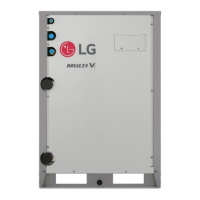78 | LIMITS / PLACEMENT
MULTI V Water 5 Source Unit Engineering Manual
Due to our policy of continuous product innovation, some specications may change without notication.
© LG Electronics U.S.A., Inc., Englewood Cliffs, NJ. All rights reserved. “LG ” is a registered trademark of LG Corp.
Figure 24: Examples of Inverted Traps.
Pipe Slope
Horizontal pipe slope must be level or slightly away from the water
source units, otherwise refrigerant and oil will migrate toward the
water source units and accumulate in the pipe segment serving the
frame that is not running or at the lowest elevation.
Piping must never slope more than -10° (see figure) without
installing an inverted trap within 6.6' of the water source unit
Y-branch and before the pipe slopes downward toward the water
source unit.
Toward indoor unit
Elevation
-10°
1. Inverted traps are required when:
a. Piping in a horizontal direction from the outdoor Y-branch towards an outdoor unit or another outdoor unit Y-branch is greater than 6.6'.
The inverted trap must be installed close to the outdoor unit Y-branch (no more than 6.6' away, 20” is optimum).
b. Anytime piping turns downward leaving an outdoor unit Y-branch toward an outdoor unit or another outdoor unit Y-branch.
The inverted trap must be installed close to the outdoor unit Y-branch (no more than 6.6’ away, 20” is optimum), and before the pipe
toward the outdoor unit turns downward.
A trap is required for piping within 8” below the unit connection(s) but not required for piping 8” or more below the unit connection(s).
Oil Trap
To IDUs/
HRUs
Oil Trap
Oil Trap
Elevation
Elevation
Elevation
Oil Trap
To IDUs/
HRUs
To IDUs / HRUs
Oil Trap
Oil Trap
Oil Trap
Figure 25: Inverted Trap Applications.
Figure 26: Allowable Pipe Slope.
REFRIGERANT PIPING FOR
SEPARATED WATER SOURCE UNITS

